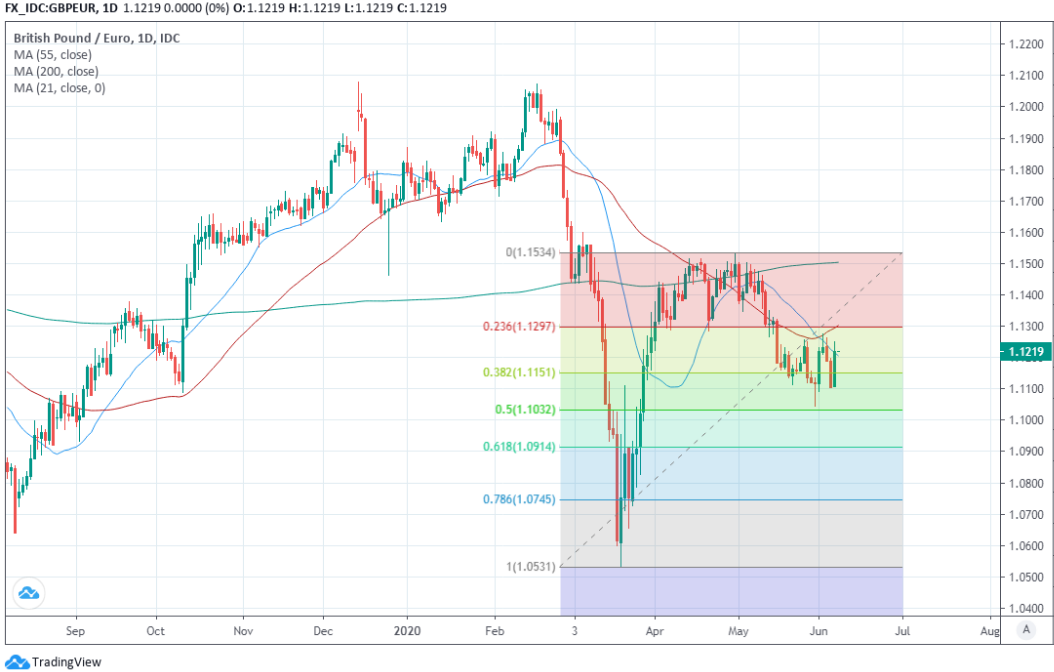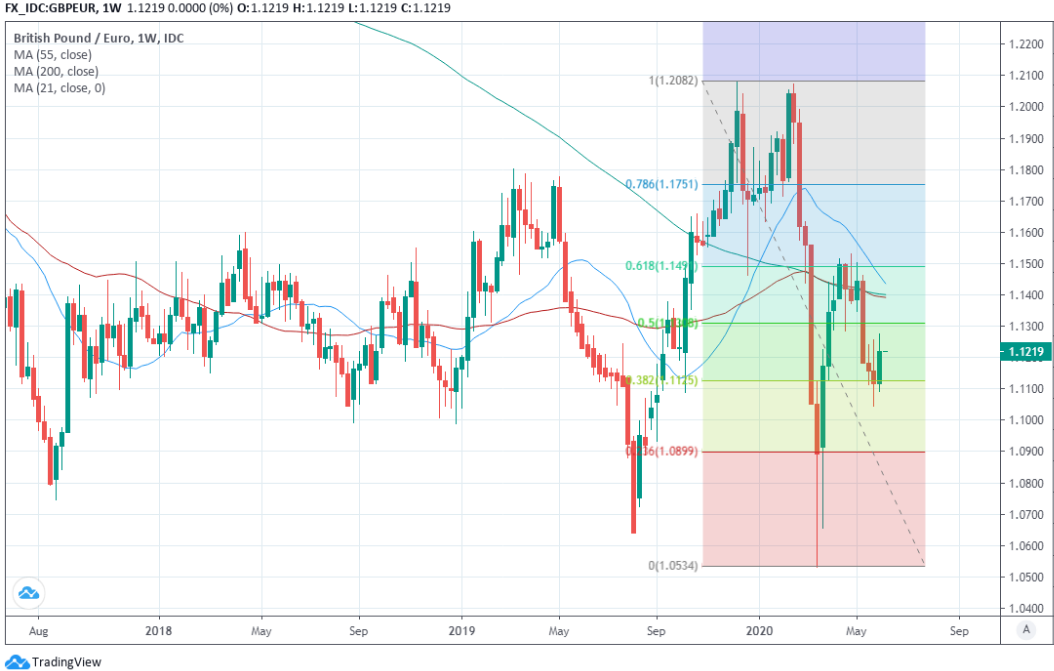Pound-to-Euro Week Ahead: Recovering Lost Ground amid Brexit Relief but Upside Seen as Limited
- Written by: James Skinner
-
- GBP/EUR finds support after Brexit trade talks extended.
- But resistance level at 1.1318 could bar the path higher.
- Brexit and BoE both seen weighing on GBP this summer.
- Risk appetite in driving seat this week, ahead of April GDP.

Image © Adobe Images
- GBP/EUR spot exchange rate at time of writing: 1.1217
- Bank transfer rates (indicative guide): 1.0890-1.0970
- FX specialist rates (indicative guide): 1.1000-1.1080
- More on acquiring speacialist exchange rates here
The Pound drew a line under a hat-trick of losses last week and could recover more lost ground over the coming days although analyst commentary suggests that any upside will be limited and also short-lived.
Sterling rose almost a full percent into Friday's close after the UK's Brexit negotiator David Frost said trade talks with the EU will continue despite no progress overcoming long-standing differences in a range of areas.
Prime Minister Boris Johnson had indicated that he might walk away from the table in June if it seemed unlikely a deal would be ready before year-end so the extension was a modest relief for the Pound.
"Any rally could prove to be short-lived if any trade deal is deemed to be lacking the components of a ‘good deal’ for the UK. Additionally, the pound remains subject to concerns about the depth and length of the covid-related downturn and these concerns are ensuring that the risk of negative interest rates in the foreseeable future is perceived to be still on the table. Despite this week’s better tone in GBP, there is so far insufficient reason for us to back away from our bearish outlook," says Jane Foley, a senior FX strategist at Rabobank.
Friday's 0.87% gain was decisive in producing the first weekly increase for the Pound-to-Euro rate since the beginning of May, given that Sterling had been threatening to break below the 1.11 level at the beginning of the session.
That threshold has broken Sterling's fall three times in the last fortnight and is backstopped by the 50% Fibonacci retracement of the March to April recovery trend at 1.1030, with the combination of the two amounting to a formidable support for the exchange rate.
"A bullish bias will be maintained while above the short term support line at .8835 and we look for dips lower to hold here," says Karen Jones, head of technical analysis for currencies, commodities and bonds at Commerzbank, referring to the EUR/GBP rate.
Jones says the Pound will meet resistance from the Euro at 1.1318 and further up at 1.1532 but notes that a move above the former might be enough to eliminate the downside bias that's gripped the exchange rate since early May. However, she and the Commerzbank team are bearish in their outlook for Sterling and look for it to fall back to 1.1005 and 1.0888 before 1.0726 over the coming weeks, and they also tip 1.02 as a possibility for the next three months.
Above: Pound-to-Euro rate shown at daily intervals with Fibonacci retracements of March-to-April rebound.
Sterling fell by around -3.5% in the month to June 06 and was down more than -5% for 2020 on Friday, although the government's decision to extend Brexit talks could be a gamechanger for sentiment in the short-term.
Extending the Brexit talks removes an immediate headwind from Sterling's path and enables it to further participate in the ongoing recovery of risk assets that was bolstered when the Bureau of Labor Statistics announced a surprise increase in U.S. employment for the month of May. But the talks remain deadlocked and are still a live risk to the British currency.
The EU continues its pursuit of what is arguably a neo-colonialist relationship that would preserve its influence and control at a time when the government seeks to end it, while also giving it 'competence' in areas like tax where it never had a voice even when the country was an official member.
The EU cites the withdrawal agreement and political declaration held up by Prime Minister Boris Johnson as deals of his own in late 2019 and approved by the British parliament in January. But Johnson's team said Friday; "the fundamentals of being an independent nation are not a negotiating position."
"Our bias into June is for a weaker pound and a test of the range lows. Our preferred expressions would be versus EUR, CHF and JPY," says Kamal Sharma, a strategist at BofA Global Research. "Seasoned followers will be cognisant that the proverbial rabbit can be pulled out the bag and that a deal may be reached. We are not as confident that this will happen before June and whilst failure to reach an agreement this month is not existential, we think markets will increasingly focus on year-end events. We therefore think GBP is likely to become more idiosyncratic and trade increasingly outside the boundaries of simple risk on/off analysis."
The prospect of something like a 'no deal' Brexit playing out at year-end will remain a risk for the Pound, along with the Bank of England (BoE) which is expected to increase its quantitative easing programme on June 18 and has flirted with the idea of a negative interest rate policy. In addition, the macroeconomic backdrop is a particular stain on the outlook for Sterling given the relatively heavy share of GDP that is made up of services sector trade, much of which has been shut down due to the coronavirus.
Above: Pound-to-Euro rate shown at daily intervals with Fibonacci retracements of March-to-April rebound.
Investors will find out this week exactly how big the bill is for the 'lockdown' used to contain the virus when the Office for National Statistics (ONS) publishes GDP figures for April, which was the first full month where the economy was under lock and key. Consensus favours a -18% month-on-month fall in GDP but any larger-than-expected contraction might be enough to get markets thinking about the volume of government spending and BoE easing that could yet be required to get the economy back on track.
The GDP data is due out at 07:00 on Friday and could ensure a soft end to the week for the Pound if it reveals that the damage was greater than markets anticipated, more so given that the UK is yet to take any meaningful steps to reopen the economy. Supposedly non-essential retailers will be able to reopen again from June 15, but this is a full month later than the U.S. and many European economies and it remains to be seen how long it will be before the restaurant and pub trades can open their doors again.
"The pound remains buoyed by the risk-on sentiment dominating markets, but Brexit risks still loom and despite the optimism helping sterling climb, negative headlines could abruptly change the path of sterling later this month,” says George Vessey, a strategist at Western Union Business Solutions. ”The stronger Euro resulted in GBP/EUR slumping towards €1.11. The €1.10 level could come into play for GBP/EUR if EUR/USD presses on towards $1.15."
Another risk and opportunity for the week ahead will be price action in the Euro-to-Dollar rate, which is one half of the Pound-to-Euro rate. Europe's single currency has risen by more than 5% since late May while the GBP/USD rate has fallen or otherwise lagged other major rivals, explaining the fall in GBP/EUR. But the Euro was sent into a tailspin against the Dollar by Friday's U.S. jobs report, potentially marking the beginning of a downward correction in EUR/USD that could help support GBP/EUR over the coming days.











